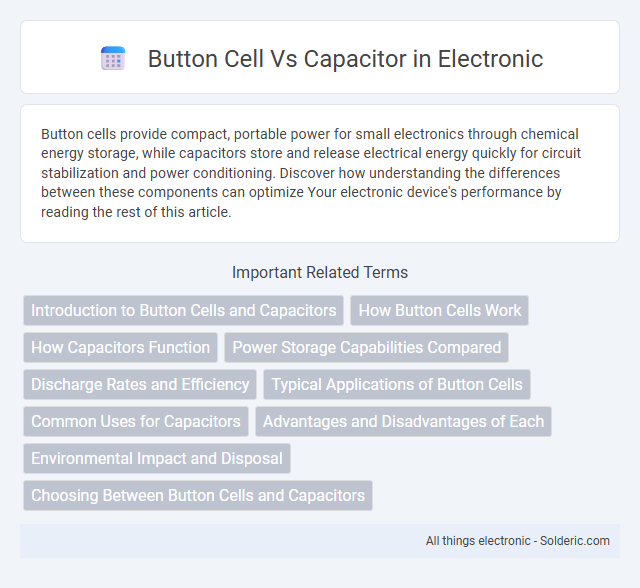Button cells provide compact, portable power for small electronics through chemical energy storage, while capacitors store and release electrical energy quickly for circuit stabilization and power conditioning. Discover how understanding the differences between these components can optimize Your electronic device's performance by reading the rest of this article.
Comparison Table
| Feature | Button Cell | Capacitor |
|---|---|---|
| Function | Provides electrical power via stored chemical energy | Stores and releases electrical energy in an electric field |
| Energy Storage | Stores energy chemically (mAh rating) | Stores energy electrically (Farads rating) |
| Applications | Watches, calculators, small electronics | Filtering, energy smoothing, power backup |
| Voltage | Typically 1.5 - 3 V | Varies widely, depends on design and type |
| Rechargeability | Usually non-rechargeable (primary cells) | Rechargeable with fast charge/discharge cycles |
| Lifespan | Months to years depending on use | Unlimited cycles, degradation over time |
| Size | Small, coin-shaped (e.g., 20mm diameter) | Varies from tiny surface-mount to large electrolytic types |
| Cost | Low to moderate | Low to moderate, depends on type |
Introduction to Button Cells and Capacitors
Button cells are small, round batteries commonly used in compact electronic devices due to their high energy density and stable voltage output. Capacitors, on the other hand, are electronic components that store and release electrical energy quickly, often used for filtering, buffering, or timing applications. Understanding the distinct roles and characteristics of button cells and capacitors can help optimize your device's performance and power management.
How Button Cells Work
Button cells, also known as coin cells, generate electrical energy through chemical reactions within a compact, disc-shaped structure, making them ideal for small electronic devices. These cells contain an anode, cathode, and electrolyte that facilitate ion movement to produce a steady voltage output. Understanding how your button cell supplies consistent power helps differentiate its use from capacitors, which store and release energy quickly without chemical reactions.
How Capacitors Function
Capacitors store electrical energy by accumulating opposite charges on two conductive plates separated by an insulating material called a dielectric. When connected to a circuit, capacitors release energy rapidly, smoothing fluctuations and maintaining voltage stability. This energy storage and quick discharge capability differentiate capacitors from button cells, which provide a steady, long-term power supply through chemical reactions.
Power Storage Capabilities Compared
Button cells store electrical energy chemically, providing steady, long-term power suitable for low-drain devices like watches and calculators. Capacitors store energy electrostatically, allowing rapid charging and discharging but offering limited capacity compared to button cells. Your choice depends on whether sustained power delivery or quick energy bursts are required for the application.
Discharge Rates and Efficiency
Button cells exhibit lower discharge rates compared to capacitors, making them ideal for long-term, low-drain applications. Capacitors deliver rapid discharge with high efficiency, supporting burst power demands but lack sustained energy storage. Your choice depends on whether you need steady energy over time or quick, efficient bursts of power.
Typical Applications of Button Cells
Button cells are commonly used in small electronic devices such as wristwatches, hearing aids, calculators, and remote controls, where compact size and long-lasting energy are essential. These batteries provide steady voltage to power low-drain devices requiring reliable, long-term energy without frequent replacement. Unlike capacitors, button cells store chemical energy, making them ideal for applications involving continuous power supply rather than short bursts of energy.
Common Uses for Capacitors
Capacitors are commonly used in electronic circuits for energy storage, power conditioning, and signal filtering, playing a crucial role in applications like smoothing out voltage fluctuations in power supplies and tuning resonant circuits in radios. Unlike button cells that serve as compact battery power sources in small devices such as watches and calculators, capacitors do not provide continuous power but instead manage and release electrical energy rapidly to support circuit stability and performance. Key uses of capacitors include coupling and decoupling signals, timing applications, and voltage regulation in consumer electronics, automotive systems, and renewable energy technology.
Advantages and Disadvantages of Each
Button cells offer a compact, reliable energy source with high energy density, making them ideal for small electronic devices, but they have limited lifespan and lower power output. Capacitors provide rapid charge and discharge capabilities with a longer cycle life and better tolerance to temperature variations, yet they store less energy and can experience leakage over time. Choosing between them depends on the application's power requirements, size constraints, and longevity needs.
Environmental Impact and Disposal
Button cells contain heavy metals such as mercury, cadmium, and lead, which pose significant environmental hazards if not disposed of properly, leading to soil and water contamination. Capacitors, particularly older models containing PCBs or electrolytes, can leak harmful substances but generally have a lower toxicity profile compared to button cells. Proper recycling and disposal methods for both components are essential to minimize your environmental footprint and prevent hazardous waste pollution.
Choosing Between Button Cells and Capacitors
Choosing between button cells and capacitors depends on power duration and energy storage needs; button cells provide long-lasting, low current energy ideal for small electronic devices, while capacitors deliver rapid charge and discharge capabilities suitable for short-term power supply and high-frequency applications. Button cells have higher energy density, making them preferred for continuous power in watches and calculators, whereas capacitors excel in applications requiring quick bursts of energy, such as signal processing and memory retention. Cost, size, and maintenance requirements further influence the decision, with capacitors offering longer life cycles without replacement compared to button cells.
Button cell vs Capacitor Infographic

 solderic.com
solderic.com